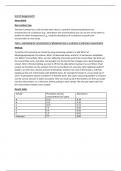Lambert beer law - Samenvattingen, Aantekeningen en Examens
Op zoek naar een samenvatting over Lambert beer law? Op deze pagina vind je 82 samenvattingen over Lambert beer law.
Alle 82 resultaten
Sorteer op
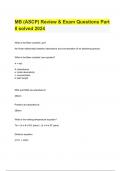
-
MB (ASCP) Review & Exam Questions Part II solved 2024
- Tentamen (uitwerkingen) • 26 pagina's • 2024
-
- €7,86
- + meer info
MB (ASCP) Review & Exam Questions Part II solved 2024 What is the Beer-Lambert Law? the linear relationship between absorbance and concentration of an absorbing species. What is the Beer-Lambert Law equation? A = ebc A: absorbance e: molar absorptivity c: concentration b: path length DNA and RNA are absorbed at: 260nm
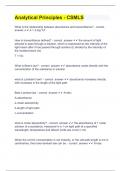
-
Analytical Principles Question and answers 100% correct
- Tentamen (uitwerkingen) • 15 pagina's • 2024
-
- €14,26
- + meer info
Analytical Principles Question and answers 100% correct Analytical Principles - CSMLS What is the relationship between absorbance and transmittance? - correct answer A = 2-log %T How is transmittance defined? - correct answer the amount of light allowed to pass through a solution, which is expressed as the intensity of the light beam after it has passed through solution (I) divided by the intensity of the incident beam (Io) T = I/Io What is Beer's law? - correct answer absorbanc...
Alongside my worksheet document, this was a distinction-graded assignment written on the beer-lambert law and finding the concentration of an unknown sample.
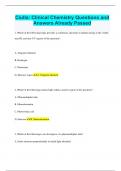
-
Ciulla: Clinical Chemistry Questions and Answers Already Passed
- Tentamen (uitwerkingen) • 171 pagina's • 2024
-
Ook in voordeelbundel
-
- €12,29
- + meer info
Ciulla: Clinical Chemistry Questions and Answers Already Passed 1. Which of the following lamps provides a continuous spectrum of radiant energy in the visible, near IR, and near UV regions of the spectrum? A. Tungsten-filament B. Hydrogen C. Deuterium D. Mercury Vapor A. Tungsten-filament 2. Which of the following isolates light within a narrow region of the spectrum? A. Photomultiplier tube B. Monochromator C. Photovoltaic cell D. Detector B. Monochromator 3. Which of the following is...
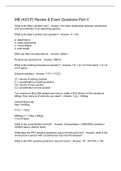
-
MB (ASCP) Review & Exam Questions Part II
- Tentamen (uitwerkingen) • 16 pagina's • 2023
-
Ook in voordeelbundel
-
- €12,29
- + meer info
What is the Beer-Lambert Law? - Answer- the linear relationship between absorbance and concentration of an absorbing species. What is the Beer-Lambert Law equation? - Answer- A = ebc A: absorbance e: molar absorptivity c: concentration b: path length DNA and RNA are absorbed at: - Answer- 260nm Proteins are absorbed at: - Answer- 280nm What is the melting temperature equation? - Answer- Tm = (4 x # of GC pairs) + (2 x # of AT pairs) Dilutions equation - Answer- V1C1 = V2C2 ...
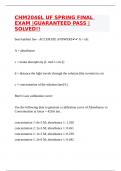
-
CHM2046L UF SPRING FINAL EXAM |GUARANTEED PASS |SOLVED!!
- Tentamen (uitwerkingen) • 44 pagina's • 2024
-
- €16,72
- + meer info
beer-lambert law - ACCURATE ANSWERS A = εdc A = absorbance ε = molar absorptivity (L mol-1 cm-1) d = distance the light travels through the solution (the cuvette) in cm c = concentration of the solution (mol/L) Beer's Law calibration curve: Use the following data to generate a calibration curve of Absorbance vs Concentration at λmax = 420.6 nm. concentration 1: 6e-5 M; absorbance 1: 1.330 concentration 2: 2e-5 M; absorbance 1: 0.451 concentration 1: 1e-5 M; absorbanc...
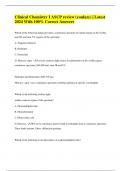
-
Clinical Chemistry I ASCP review (youlazy) | Latest 2024 With 100% Correct Answers
- Tentamen (uitwerkingen) • 173 pagina's • 2024
-
- €11,80
- + meer info
Which of the following lamps provides a continuous spectrum of radiant energy in the visible, near IR, and near UV regions of the spectrum? A. Tungsten-filament B. Hydrogen C. Deuterium D. Mercury vapor - A most common light source for photometry in the visible region. continuous spectrum (360-800 nm). near IR and UV. Hydrogen and Deuterium (200-375 nm) Mercury vapor- not a continuous spectrum, emitting radiation at specific wavelengths Which of the following isolates light within a na...
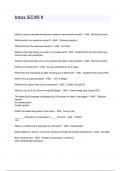
-
Intox EC/IR II Study Exam Questions And Answers
- Tentamen (uitwerkingen) • 3 pagina's • 2023
-
- €10,32
- + meer info
Intox EC/IR II Study Exam Questions And Answers What is used to calculate the alcohol content in each breath sample? - ANS Electrical current What results in an electrical current? - ANS Chemical reaction What produces the chemical reaction? - ANS Fuel Cell What are the only things you enter in a practice test? - ANS Subjects first and last name and normal court with jurisdiction. Will the instrument allow you to run another test after it was aborted? - ANS After 20 min...
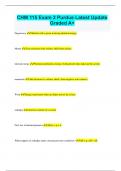
-
CHM 115 Exam 2 Purdue Latest Update Graded A+
- Tentamen (uitwerkingen) • 5 pagina's • 2024
-
Ook in voordeelbundel
-
- €8,84
- + meer info
CHM 115 Exam 2 Purdue Latest Update Graded A+ Degeneracy Orbitals with a given n having identical energy Metals Lose electrons from valence shall form cations internal energy Potential and kinetic energy of all particles that make up the system nonmetals Add electrons to valence shells, form negative ions (anions) Work Energy transferred when an object moves by a force enthalpy total heat content of a system First law of thermodynamics ΔEsys = q + w What happens to enthalpy under constan...
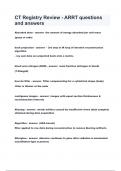
-
CT Registry Review - ARRT questions and answers
- Tentamen (uitwerkingen) • 18 pagina's • 2024
-
Ook in voordeelbundel
-
- €12,78
- + meer info
Absorbed dose the amount of energy absorbed per unit mass (grays or rads) back projection - 3rd step in IR loop of iterative reconstruction algorithm - ray sum data are projected back onto a matrix. blood urea nitrogen (BUN) renal function (nitrogen in blood) (7-25mg/dl) bow-tie filter Filter compensating for a cylindrical shape (body) -filter is thicker at the ends contiguous images images with equal section thicknesses & reconstruction intervals Alia...

Wist je dat een verkoper gemiddeld €76 per maand verdient met het verkopen van samenvattingen? Hint, hint. Ontdek alles over verdienen op Stuvia

